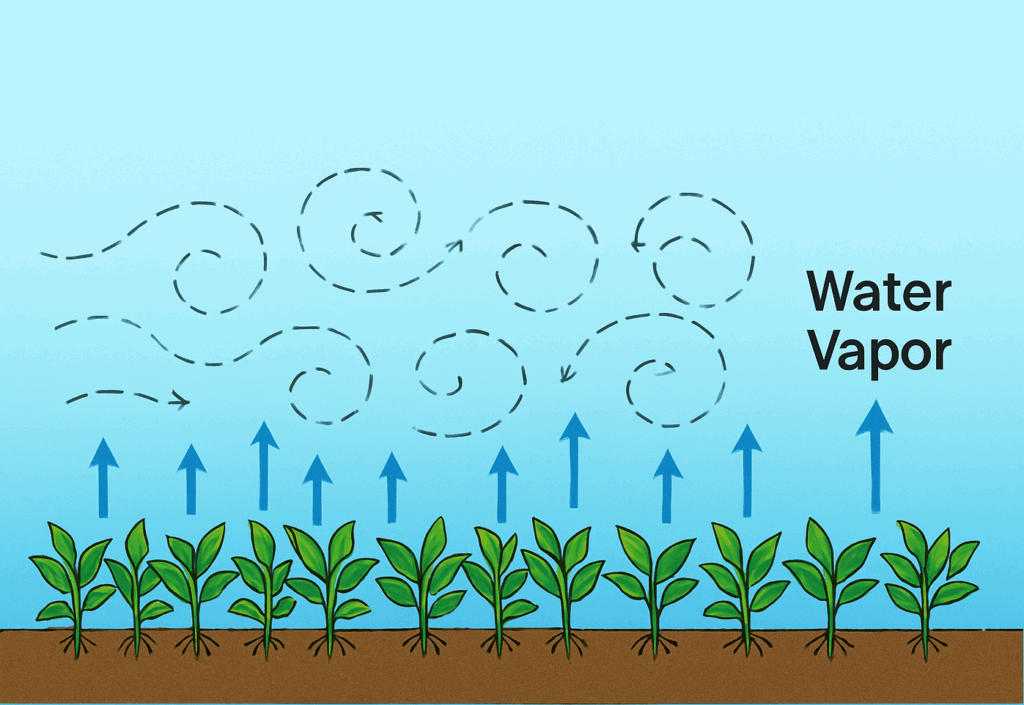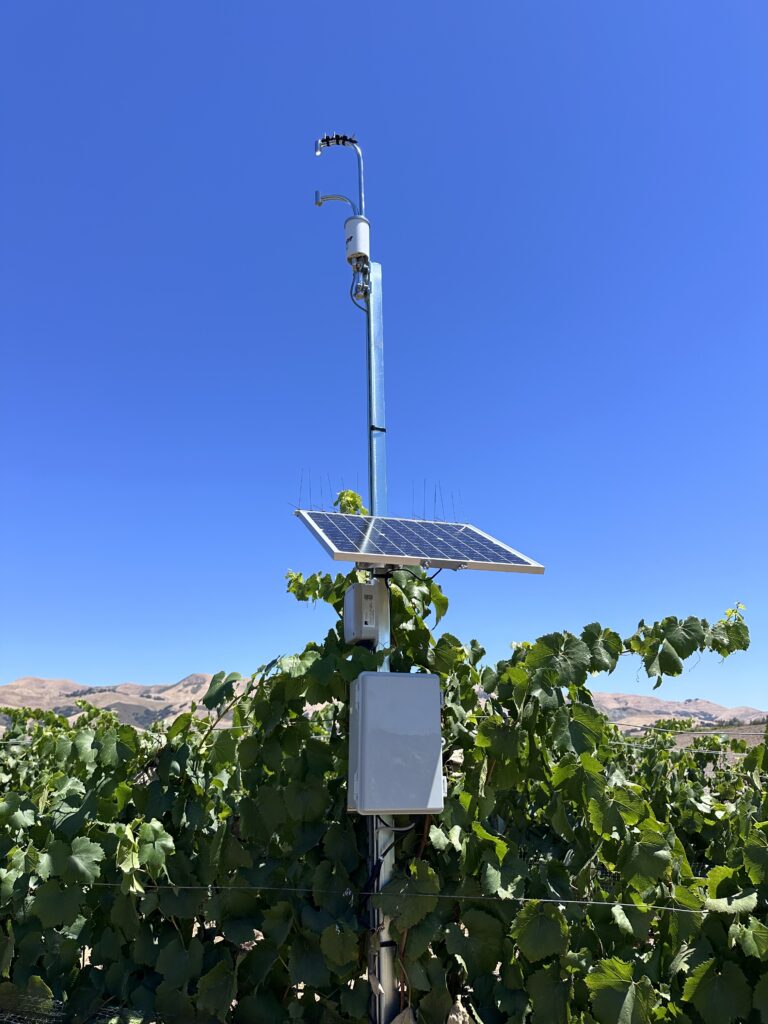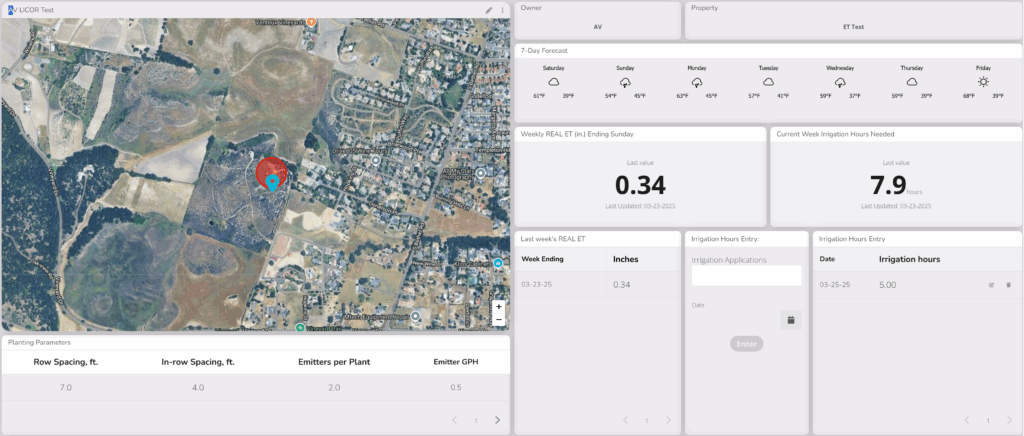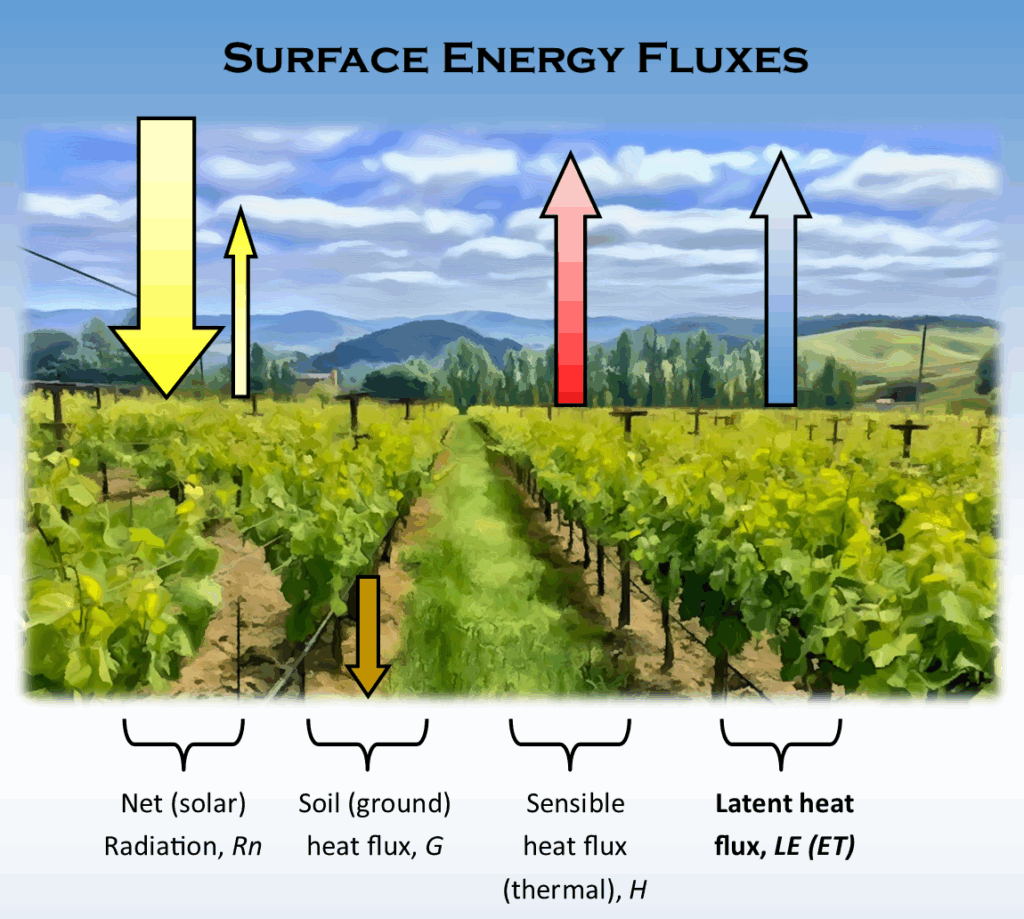Who (or what) is this eddy you keep talking about?
Efficient water management has never been more critical for agriculture and specifically for viticulture. High-end viticulture needs to manage water to not only cut costs, but to keep quality high in a market of oversupply and buyers who hold the upper hand over the grower. High production viticulture may not need the water management finesse for quality that high-end viticulture does, but regulatory demands for groundwater protection as well as limitations on water deliveries push growers into making the most out of every gallon.
Here at AV, we’ve made use of impactful technologies to help growers irrigate efficiently and control vine stress to improve wine quality from their vineyards. Our primary tools have been the soil moisture probe and, more recently, the Florapulse microtensiometer. Both tools have been indispensable and even more so now that we have our own data portal to view and analyze these data streams. More recently, we’ve been working with a new tool, an eddy covariance device, for direct measurement of ET, which gives us another approach for irrigation management that we didn’t have before. Before I introduce this new tool, let me explain what direct measurement of ET is and how it differs from other ET measurements.
Eddy Covariance – who is this guy?
Eddy is not just your buddy down the road with whom you share a good laugh occasionally. Eddy or more meaningful, eddies, are swirls of turbulent air which we experience daily but don’t give a lot of thought. Unless you’re a micro-meteorologist like I am. Yes, I am one of those. I did my Ph.D. in micrometeorology of the vineyard environment so I know a thing or two about it. Let me give you the nickel tour of micrometeorology (let’s call it micromet for short), eddies, and how eddy covariance is used to measure ET.
Wind does not blow in a straight line. As air flows across the earth’s surface, or on a micromet-scale, the surface of a field, forest, desert, or whatever, it experiences friction from that surface. Air flow at the very surface of the earth is zero, because wind cannot penetrate the earth. So, as the wind blows across the surface, the portion closer to the ground experiences drag from the friction, which is enhanced by objects, such as buildings, trees, and of course grapevines. This friction causes a shear force in the air flow field, which creates the turbulent eddies. And these eddies swirl and interact with other masses of air, creating more eddies. These wind shear eddies are smaller than the primary eddies, and these smaller eddies interact with other packets of air, creating their own eddies. And so on and so on. So, indeed air does not flow in a straight line, with some exceptions like katabatic wind during the very still night when cold air sinks. Those flows are not turbulent, but during the day, you can count on turbulent eddies all over the place. You can see this if you look at smoke rising and then swirling: initially it rises quickly because of convection from the heat, but as it cools, it gets taken by the air and you can then see what the eddies look like.
So, now that you know what an eddy is, let’s discuss why It’s important to us, not only for agriculture, but as humans. Without air movement, everything that is generated at the earth’s surface (e.g. dust, CO2, farts, and yes water vapor) would have to rely on diffusion from high concentrations at the surface to lower concentrations in the atmosphere above. Thankfully, that is not the case. The wind, with its turbulent eddies, facilitates the movement of gases and suspended particles (called aerosols) from the surface to the sky.
In the case of water vapor, the water vapor concentration (when it is not raining) is higher within and just above a plant canopy than it is in the air above the canopy. Turbulent eddies mix the moister air below with the drier air above (Fig. 1). In the portion that is swirling upward, vapor is brought upward. In the portion that is swirling downward, drier air is brought downward.

We can measure this! Eddies can be measured using high-speed anemometers. A sonic anemometer looks like a stethoscope, but it is really a pair of speakers and microphones. Several times per second the speakers emit an ultrasonic pulse, which is captured by the microphone on the other end. The time it takes for the sound wave to reach the microphone on the other end is measured and the difference in time between the two directions is a measurement of instantaneous wind speed. We can measure the turbulent air field this way and meteorologists can measure this in 3-D. For us, we only care about one axis – the vertical one. Because movement horizontally just moves vapor across the field and we only care about what is moved upward. So, the 1-dimensional sonic anemometer measures the fluctuations in vertical air movement. Over time, the net air movement is zero because the earth blocks vertical air movement. So, we only care about the fluctuations in the vertical direction.
We can also measure water vapor, or humidity, at the same high frequency. When air swirls upward, the moisture air registers an increase in humidity and when it swirls downward the drier air brought in registers a decrease in humidity. If we record the instantaneous vertical air velocity along with the instantaneous humidity, and take the covariance of the two over a time interval, we get a direct reading of water vapor flux. This is what eddy covariance is!
If it sounds complicated, you’re right it kind of is, but fortunately this is established technology and the covariance is computed on the fly by either the device itself or the equipment used to log the data. In my graduate research, and in my early professional career, I used eddy covariance equipment. The cost back then was about $30,000 in today’s dollars. You can find them now for that or much higher for use in micromet research. So, while eddy covariance equipment has long been the gold standard for ET measurements, its high cost has rendered it primarily a research tool, though developers of other ET methods have and are still using it as a standard to calibrate their approach.
That’s nice, but the gold standard is too expensive to use to directly measure ET
That’s right, equipment for eddy covariance has been just too costly to use as a source of daily ET measurements. Until recently, at least. Last year Li-COR, a company out of Nebraska who have been making plant and environmental research equipment for decades, released their LI-710 Evapotranspiration Sensor (Fig. 2), which is a simplified, but still effective, eddy covariance sensor in a small and rugged package. The best thing about it is the price tag, which is a fraction of the cost of a traditional eddy covariance system and puts it right into the cost-effective range for commercial agriculture. The device computes eddy covariance internally and communicates digitally to a datalogger.

Last year, overjoyed with this new technology, we entered into a reseller agreement with Li-COR and purchased some units to get more familiar with and to do some design for the best data logging and telemetry solutions. We’ve made substantial progress and have also developed an app to track ET and to help growers make determinations of irrigation from the information (Fig. 3).

Why use this over other ET measurement methods?
Our motivation for this blog post is to announce this new technology and not to disparage other technologies out there, but we should at least briefly discuss why it is such an exciting development for us and for agriculture in general.
Probably the most common way to obtain ET measurements is by using weather stations and using that information to determine reference ET (ETo) using the modified Penman equation. Weather inputs of solar radiation, wind speed, temperature and humidity are used to determine Daily ETo. Almost all weather stations will provide values for ETo, as this is a standard and common method. That said, ETo itself has limited utility, as it is based on the theoretical ET of a hypothetical reference crop (a mixed grass mowed to a certain height) and does not indicate the ET of the crop (ETc). For many crops, including grape vineyards, ETc is a fraction of ETo.
To determine ETc, ETo is multiplied by a crop coefficient (Kc). These crop coefficients are basically a “fudge factor” to represent the fraction of ETo that the actual crop experiences. Kc values will vary during the growing season as the canopy develops and then senesces, usually peaking around veraison, holding steady and then dropping near or after harvest. Kc values have been computed and published by many researchers for many different crops, including grape vineyards. However, they are prone to error and we have found, using soil moisture as our guide, that we can irrigate far less than the amount ETo*Kc produced without long-term loss of soil moisture. So, actual Kc is likely substantially lower than published values of Kc are telling us based on our experience.
In fact, last year we ran some REAL ET eddy covariance measurements and compared them with ETo computed from nearby weather stations and found effective Kc values of around 0.35 for a full canopy in three vineyards, compared with published values of around 0.6. That’s a big difference!
Surface renewal has been a popular method of ET determination in recent years. While surface renewal is a valid micromet method, we should caution that it is not a direct ET measurement. Rather, it is based on a surface energy budget (Fig. 4). Let me explain. The energy budget of a field (or any other part of the Earth’s surface) is comprised of four basic flux components:
1) Net radiation flux, Rn, which is the amount of solar radiation that provides energy to the surface (downwelling radiation minus reflected radiation)
2) Ground heat flux, G, which is energy that warms the surface of the soil and penetrates into deeper levels
3) Sensible heat flux, H, which is energy dissipated into the air by heating of the air from soil and leaves and is transported into the ambient environment by turbulence, just like water vapor is
4) Latent heat of evaporation flux, LE, which is energy used to evaporate water from liquid into vapor, which is then transported into the ambient environment by turbulence, just like sensible heat is.

The surface renewal approach measures not latent heat flux or water vapor flux, but it measures sensible heat flux. To determine latent heat flux, and from that, evaporation flux, the energy budget is used to net out that term. Usually, the other two terms, Rn and G, are estimated, and whether or not estimated or measured, each term in the energy budget equation represents a source of potential error. The net of it is that surface renewal is prone to error, unlike eddy covariance, which is a direct measurement of water vapor movement and does not require any assumptions or models.
Are there any limitations on where eddy covariance can be used?
Yes, there are limitations, which are pretty much the same limitations that surface renewal has. The field needs to be a decent size – large enough to provide a few hundred feet of upwind fetch to the sensor. This is to allow the flow field to stabilize and avoid edge effects, like from roads and ponds. And while the field should ideally be flat, sloped fields can be used as long as the slope is relatively consistent. We tested the LI-710 over some uneven and sloped vineyards last year and got good readings from those, but site selection is important and tiny little “island” vineyards are simply not candidates. This is true for both surface renewal and eddy covariance sensing techniques.
That said, most commercial-scale vineyards will be able to use this new device and we look forward to rolling them out to early adopters in this and upcoming growing seasons!

